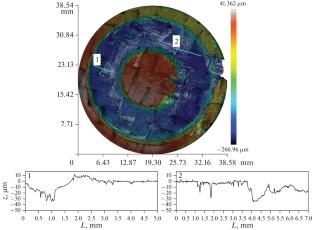Influence of the Fiber Bedding Direction on the Fiber Composite Wear
Abstract—
The fibrous composite wear rate dependence on the angle between the sliding direction and the direction of the fibers on the friction surface, when fibers in the material are parallel to the friction surface was studied. For this purpose, an experiment was carried out on the wear of a composite material sample based on carbon fiber and a carbon matrix in the form of a disc with a ring-shaped counterbody made of silicon carbide ceramics. The structure of the composite made of carbon twill weave forms on the friction surface areas with fibers oriented parallel to each other and the surface of the material. Setting up the experiment according to the “ring–disk” scheme allows one to obtain a different angle between the direction of the fibers and the direction of sliding in one test. Based on the results of the friction surface relief study after the tests, the relative wear rate of the surface areas, which are characterized by different directions of the fibers, is determined. It was found that areas with fibers directed at an acute angle to the friction direction have greater wear resistance, and fibers located at a right angle to the direction of sliding are more susceptible to destruction during wear. A wear process model of an individual fiber up to its complete destruction is constructed. A phenomenological criterion for the destruction of an individual fiber is proposed, which makes it possible to estimate the effect of the angle between the direction of the fiber and the direction of sliding on the destruction of the fiber. An algorithm for determining the coefficients included in the proposed wear model, based on a limited number of tribological tests, is proposed.


 求助内容:
求助内容: 应助结果提醒方式:
应助结果提醒方式:


